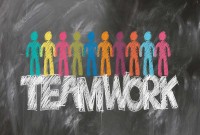- Home
- Business Processes
- Industry Knowledge
- Aerospace Industry
- Automotive Industry
- Banking Domain
- BFSI Industry
- Consumer/ FMCG Industry
- Chemicals Industry
- Engineering & Construction
- Energy Industry
- Education Domain
- Finance Domain
- Hospitality Domain
- Healthcare Industry
- Insurance Domain
- Retail Industry
- Travel and Tourism Domain
- Telecom Industry
- Leadership Skills
- eLearning
- Home
- Leadership
- Leadership Theories
- Storming Stage of Team Development
Storming Stage of Team Development
Storming is the second stage of team development and this stage is characterized by a bid for power and inter-personal conflicts. Learn the key factors that occur in the storming stage and the strategies that a team leader can adopt to pass this stage of high winds
Managing Team Conflicts in the Storming Stage
Storming is the second stage of team development and in this stage, members start competing for status, leadership, and control in the group. When group members get to know each other better, the storming stage begins. This stage is characterized by a bid for power. Every team will move through this phase. Some will stay here longer than others. During the Storming stage, conflicts arise as team members try to figure out their roles and delegate tasks. This stage can be difficult, but it can also be highly productive.
Characteristics of the Storming Stage:
Key factors that occur in the storming stage for the team members might include:
- Individuals understand others' behavior and assert their role in the group.
- Team members may compete for a certain role or position on the team.
- The leader’s authority may be challenged as others compete for the position.
- As a result inter-personal conflict starts.
- Members try to resolve the issues related to the task and working relations.
- They also resolve the issues related to the role of the individual in the group.
- Roles and responsibilities get clarified to a certain extent.
- The rules and ways of working as a team start to be defined.
- The team still lacks established processes.
- The team lacks strong interrelationships with their colleagues.
- Some members may feel overwhelmed by how much there is to do.
- Some members may also feel uncomfortable with the approach being used.
- Some may even start questioning the appropriateness of the goals of the team.
- Some may start resisting taking on tasks.
- Members will begin to open up but also confront each other on ideas.
- Can be painful to team members who are reluctant to deal with conflict.
- Politeness tends to begin to wear off and dissension can occur over.
- Control often becomes the primary issue.
- Disagreements can be either very obvious or subtle.
- Sharp fluctuations in attitude about the team and the project's chance of success.
- Arguing among members even when they agree on the real issues.
Managing Conflict during Storming:
As team members struggle over roles and responsibilities, conflict can arise. But it can also be a highly creative stage as ideas are generated and challenged, and important issues are discussed. Identify what some of the problems are they will need to solve. If they're to move to the next stage, team members must learn to voice disagreement openly and constructively while staying focused on common objectives and areas of agreement. During the Storming stage, to help team development, you should focus on team building to ensure that people can get to know one another and not get stuck in seeing each other as competitors.
Suggestions for the Team Lead/Member in this stage:
To make sure that Storming results in positive growth, the team leader needs to:
- Establish process and structure
- Ensure that everyone stays on track with the team's goal, and
- Help the team define a shared vision
- Work to smooth conflict and build good relationships between team members.
- Allow and encourage productive conflict.
- Need to remain professional and objective.
- Allow each member to share their ideas or ask for input.
- Be open to every team member's input
- Help members to understand and appreciate the other members’ knowledge and skills.
- Generally provide support, especially to those team members who are less secure.
- Remain positive and firm in the face of challenges to your leadership or the team's goal.
- Perhaps explain the phases of team development so that people understand why conflict's occurring, and understand that things will get better in the future.
- Compliment team members.
- Review team goals and ground rules
- Address problem behaviors
- Check processes regularly
- Assure the team of progress
- Apply conflict management techniques
Every team will move through this phase. Storming is the most difficult stage for a team to weather, and this is the stage when many teams fail. Some teams may stay here longer than others. Storming is necessary for healthy team development. When team members begin to trust one another enough to air differences, this signals readiness to work things out.
Related Links
You May Also Like
-
In its simplest sense, decision-making is the act of choosing between two or more courses of action. Decision making is a key skill in the workplace and is particularly important if you want to be an effective leader. When decisions have to be made, there are several stages that you should go through to reach a practical solution. Understand the meaning and importance of decision making and how to look at it as a process.
-
Have you ever noticed how we express ourselves or interact with each other? Have you ever wondered what communication is and what role it plays in our lives? One may wonder if communication is so omnipresent and integral to our lives, why study communication at all? We need to study communication because it is a complex process that consists of many elements and is also beset with a number of barriers and there is a need to remove the barriers so that the communication process is effective.
-
Teams are part of the modern organizational culture. Whether you are a team leader or a team member, having a better understanding of how teams work, and being able to identify where the team is in the process, is a critical part of ensuring the team is ultimately successful. Start with the basics and understand what a team is and what role they play in an organization.
-
Collaborative leadership is all about collaborative problem-solving and decision-making or can also be defined as the leadership of a collaborative effort. . The term started to appear in the mid-1990s in response to the formation of long term public-private partnerships to rebuild public infrastructure. Learn how you can use principles of collaborative leadership to enhance your leadership skills for being an effective leader.
-
Effective Business Communication
Communication is all about getting the message across correctly. To make this happen, you need to have good speaking skills and good writing skills. If you have these skills coupled with good listening skills and interest in reading, you have all the potential to be a good communicator. What things should the leader take into consideration to be more effective with interpersonal communication?
-
Benefits of Teams in Workplace
The use of formal work teams is commonplace in modern organizations. But why we have teams? What are the benefits or advantages that teams provide for organizations and employees? Do we really need to adopt formal team structures and use team-building approaches in organizations? Read this article to explore and learn the benefits of having formal teams in organizations.
-
Many people think communication is easy. It is said that communication can never be a hundred percent complete. Many factors are involved in the process of communication and something can always go wrong with one or more of these. It becomes difficult and complex when we put barriers in communication. Recognize barriers to interpersonal communication and examine specific strategies for overcoming those barriers.
-
Stress is an essential part of our life. No one can live without stress. Stress can be beneficial as well as harmful. Stress as a positive influence adds excitement and hope while as a negative influence it can result in destructive feelings, anger, and depression. Although the general orientation to stress is to consider unfavorable outcomes, yet one must have observed that stress experiences may also facilitate the development of effective and varied coping behavior, increased personal resources, and lead to a sense of competence in development. Stress at a moderate level is not only inevitable but may be useful for physical and mental well-being.
-
Creating Highly Effective Teams
How do we create effective teams? What comes to mind when you think about an effective team? High performing teams exhibit accountability, purpose, cohesiveness, and collaboration. It is a team that works seamlessly as a whole. Everyone brings unique talents and strengths and support each other to bring out the best in everyone. How do you create one?
-
Reasons behind Wastage of Time
Under-utilization of time may be due to the faulty system or faults of manager/officer/leader or due to lack of planning. There could be many factors driving the procrastination behavior like system issues, personal work habits, and lack of delegation, personality traits, and bad working habits of the leader, failure to tackle interpersonal conflicts, obstacles, and lack of far-sightedness.
Explore Our Free Training Articles or
Sign Up to Start With Our eLearning Courses

About Us
Learning
© 2023 TechnoFunc, All Rights Reserved










